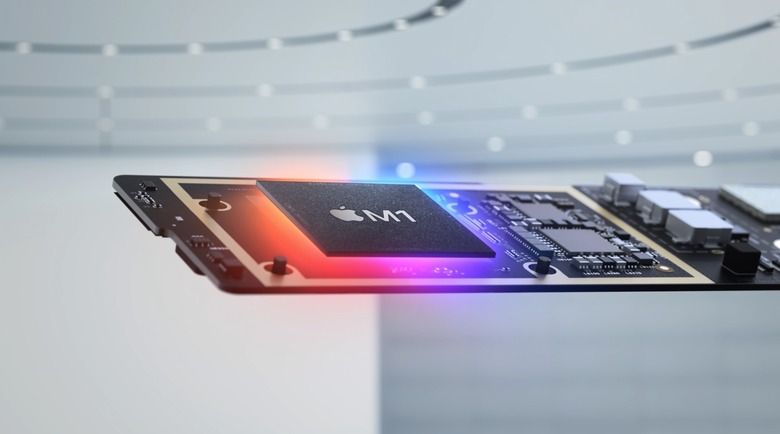Apple's M1 Chips Might Just Be The Beginning Of Intel's Nightmare
Apple just launched its first custom processor for computers. The M1 chip is similar to the A-series processors inside the iPhone and iPad, and it powers just two devices: The late 2020 MacBook Air and MacBook Pro. And yet, Intel is still terrified, having mounted a massive ad campaign in an attempt to convince the world that the M1 MacBooks can't stand up to Windows 10 laptops running on Intel hardware.
The campaign was somewhat half-baked, and has since drawn criticism and ridicule for its missteps. The M1 MacBooks offer formidable performance and excellent battery life, with M1 being built on a chip technology unavailable to Intel. If anything, Intel's campaign is drawing more attention to the potential of ARM processors when it comes to notebooks and desktops. And Intel's ARM nightmare is only just beginning.
Apple is one of many companies developing custom chips for computers. Qualcomm used Snapdragon platforms designed for Android smartphones and tablets to power laptops several years ago. They weren't as speedy as the M1 MacBooks, but they delivered great battery life. Qualcomm continued to upgrade the ARM chips for Windows 10 devices, launching the custom 8cx platform. Microsoft launched its own Surface laptop using an ARM chip. Intel never contested those devices, as none of them were able to outperform Intel-powered rivals.
The M1 chips have raised the bar, though, forcing everyone else to compete. Google is rumored to be working on its own SoC for Pixel phones. Variations of the chip might be used for Pixelbooks and other hardware. Samsung is also expected to develop an M1 competitor. Samsung just fixed the Exynos line with the new 2100 series, and it's undoubtedly looking for ways to improve its silicon for future Android devices. And Samsung has launched Windows hardware running on Qualcomm chips in the past. Making its own ARM chip for Windows 10 laptops might also be on the agenda for a company that has been quick to follow in Apple's footsteps.
But Qualcomm's unannounced 8cx platform that just appeared in benchmark tests is the best indication that the M1 is the least of Intel's worries. A Qualcomm Reference Design (QRD) platform, believed to be a version of the Snapdragon 8cx Gen 3 SoC, was discovered in the Geekbench database. The scores suggest a massive performance boost over the previous designs.
The Snapdragon 8cx candidate packs eight high-performance cores, although only four are working at top speeds. Qualcomm could further tweak performance for the final product, but the current reference design is 35% faster than 8cx Gen 1 and 24% faster than 8cx Gen 2 in single-core tests. The M1 chip scored 74% better in single-core tests than the 8cx Gen 2, and AMD and Intel processors also beat the new Qualcomm design. The M1 outperformed those chips as well.

Benchmark and specs comparison between the leaked Qualcomm Snapdragon 8cx Gen 3 platform and other laptop chips including Intel, AMD, and Apple silicon.
More interestingly, the Gen 3 candidate's multi-core score nearly matches Intel's 11th Gen Core i7 Tiger Lake mobile chip. Tom's Hardware put together the comparison above that lists performance and specs for the various chips. Geekbench scores do not tell the whole story, and real-life performance might vary, but Qualcomm has plenty of time to increase the clock speeds and even raise the thermal load if need be.
Even if it's not able to match the M1 this year, the new 8cx might deliver an even speedier Windows 10 experience than before. Add in great battery life, and Windows on ARM might turn out to be a much bigger problem for Intel than the M1. And let's not forget that Intel can't even match the chip technology that Apple and Qualcomm are working with. Tiger Lake chips are 10nm chips, while the M1 is built on a 5nm process, just like the A14 Bionic. The Snapdragon 8cx Gen 2 is a 7nm SoC.
All of this explains why Intel is trying to make ARM chips look bad by targeting Apple's M1. More device makers might soon look at ARM offerings from Qualcomm and others for their new devices. Microsoft will be one of them, as the company is expected to continue to upgrade the Surface Pro X in the future. And Microsoft is also working on improving the Windows on ARM experience. You can see why Intel is panicking.
